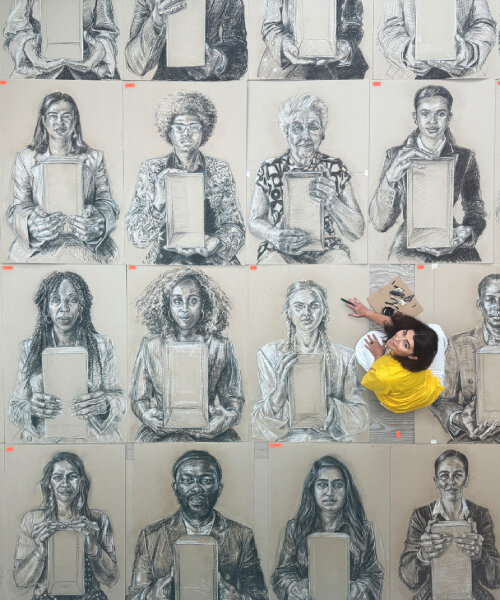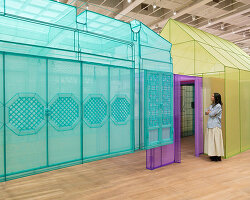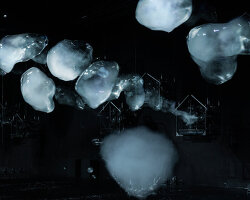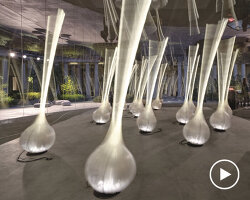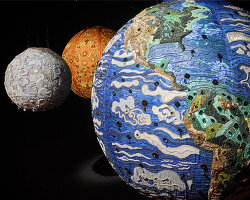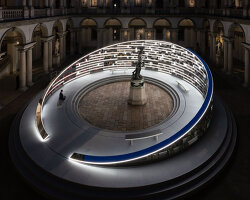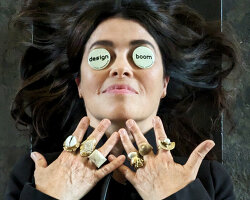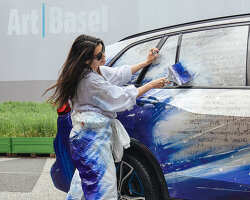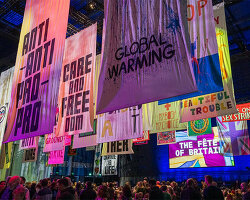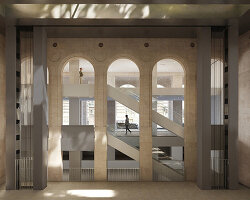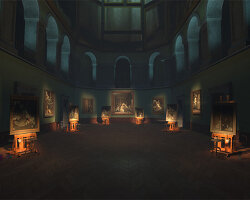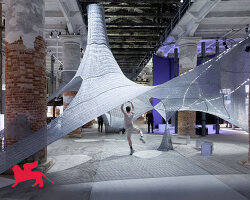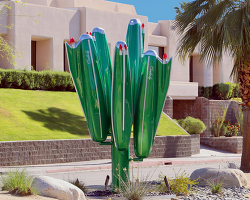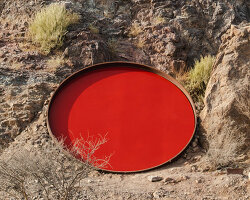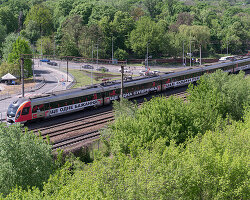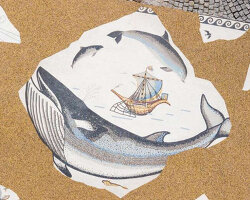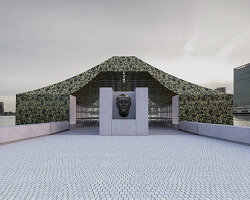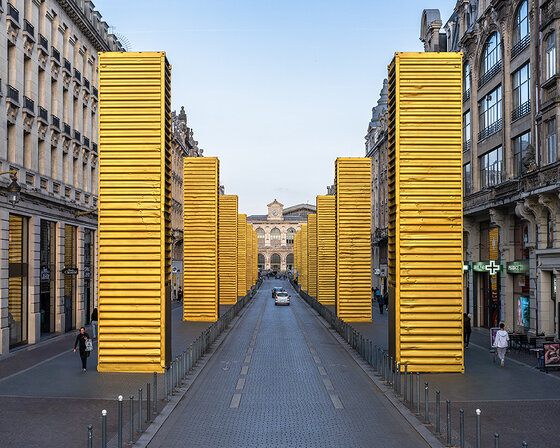Es devlin’s congregation, an installation of portraits in london
Months after her box of rain ‘Surfacing’ appeared at Art Basel 2024, Es Devlin returns with Congregation. In a conversation with designboom before the unveiling, she unpacks her recent large-scale installation involving fifty portraits of fifty displaced people, those who were forced to leave their homelands because of wars and conflicts. Working with the UK for UNHCR, the United Nations Refugee Agency, the English artist hosts a show of collective drawings, a hint at its title Congregation, inside the St Mary Le Strand church in London between October 4th and 9th, 2024, in time for Frieze London 2024.
These illustrations are accompanied by public choral performances within the surrounding area of the Strand, outside The Courtauld, at 7pm each evening (except Monday). Fifty portraits of displaced people are arranged on multiple levels inside the church. They’re drawn using chalk and charcoal on cardboard, and each portrait is holding an empty box. Es explains to designboom that as soon as the show begins, the one Ekow Eshun curated in collaboration with King’s College London and in partnership with The Courtauld, fifty light paintings that she herself has made are projected onto the box as animations, filling it up with specific objects that are dear to her subjects.
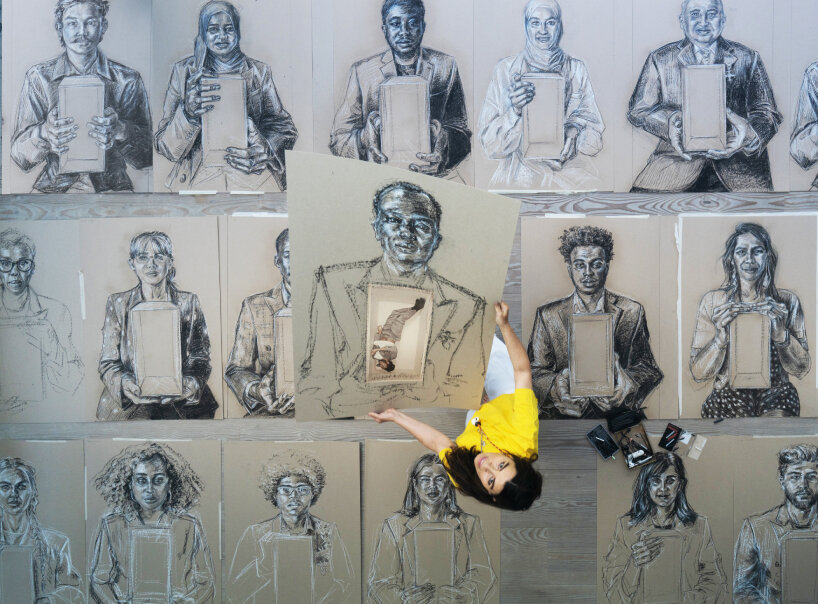
all images courtesy of Es Devlin | photo by Daniel Devlin
portrait Installation inside St Mary Le Strand church in london
During our conversation, the English artist tells us that she wants Congregation to be a performance, a show. Visitors who book tickets (more here) see a projected film sequence that has been created with the filmmaker Ruth Hogben and choreographer Botis Seva. The empty boxes of the fifty portraits first have dancer Joshua Shanny-Wynter performing in them, all the while viewers listen to the voices of the displaced people, flooding into the St Mary Le Strand church as part of the sound sequence composed by Polyphonia. There’s a sound installation that features poetry by the Kinshasa-born poet JJ Bola, who is also featured in the portraits, as well as extracts from Recomposed by Max Richter: Vivaldi’s Four Seasons.
Es Devlin’s installation in London has also begun with a word. In October 2022, then UK Home Secretary Suella Braverman described asylum seekers traveling on small boats toward the Kent coast as an ‘invasion.’ The artist felt a dissonance she couldn’t comprehend. She asked the UK for UNHCR for help to understand, and they shared with here the data on displaced people. She found out that there are 117 million displaced people in the world, with 73 percent of all refugees originating from five countries: Afghanistan, Syria, Venezuela, Ukraine and South Sudan. ‘They showed me the data, and I thought, well, there must be structures of separation—some structures of ‘otherness’—that we need to look at,’ she shares with designboom, and looking into this otherness is exactly what she’s done.
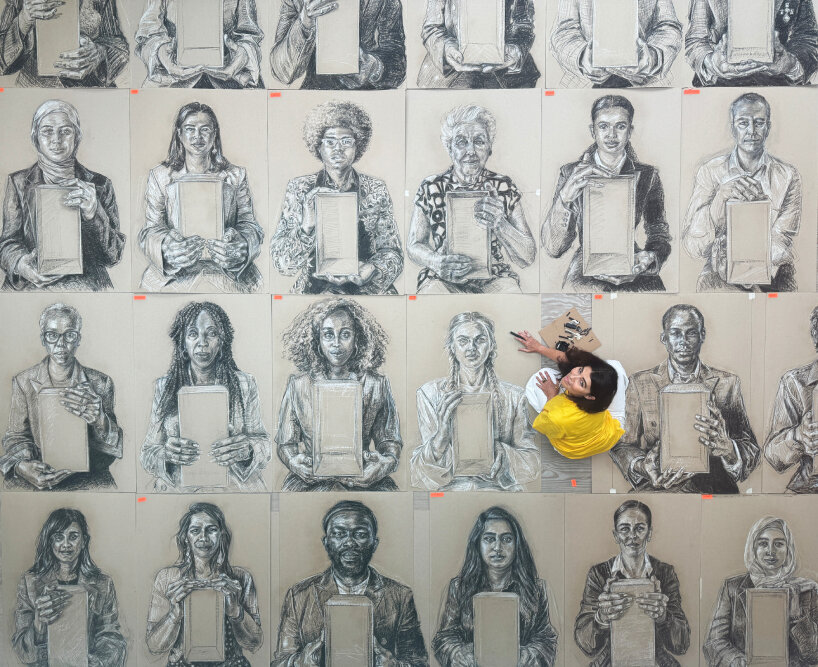
Es Devlin’s Congregation, her London installation with drawings of 50 displaced people | photo by Tayo Shonibare
50 displaced people open up to es devlin for congregation
Fifty strangers with fifty stories, drawn by one artist in her London studio. UK for UNHCR has briefed the subjects and the artist on what happens: they come through her doors by themselves or often with someone to offer support, if needed, and Es Devlin only knows their first name and nothing else. She doesn’t know how they’ve arrived in London or what has happened to them. She agrees on one condition: everyone wears a suit or dresses up as if it were a formal occasion. ‘I did it because I wanted to destabilize my preconceptions, judgments, and biases. I wanted to have an encounter with a face to begin with,’ she explains to designboom.
One by one, they enter her studio and sit before her. It’s quiet. No one’s talking. Both of them are just listening to Max Richter’s recomposition of Vivaldi’s Four Seasons playing in the background. In the lull of violins, they look directly into each other’s eyes without speaking, at times crying just by listening, looking, and being in the present solitude. When the recording reaches track 14, Shadow 1, Es Devlin pauses the tracks. She grabs the microphone and says, ‘Tell me about yourself.’ For five months, between April and August 2024, fifty displaced people opened up to Es Devlin. They’ve told her who they are, what they’ve been through, and how they’ve been forced to leave their home countries and re-establish themselves in a foreign land, culminating in a large-scale installation in London.
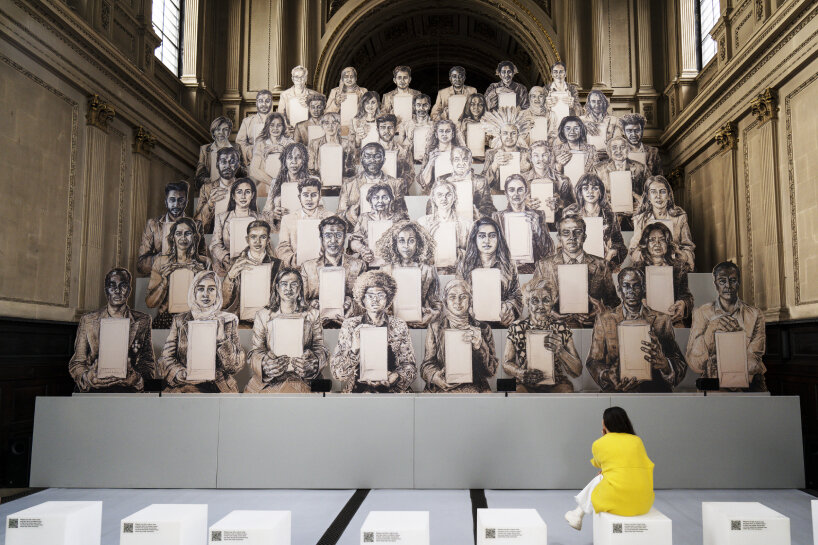
St Mary Le Strand in London hosts Es Devlin’s installation, Congregation | photo by Daniel Devlin
At one point in our interview, Es Devlin admits she doesn’t like the word ‘refugee.’ ‘It’s started to accumulate associations that aren’t helpful,’ she tells designboom. ‘I was looking for new words and thought: what about those who bring gifts, like the three kings? What if we start looking at this community not fearfully about what they’ll take, but excited about what they’ll bring? We could look at anyone being born that way. Any new birth migrates from pre-life into life through the womb—they’re still on a journey. Are they going to bring gifts, or are they going to take? We don’t know whether they’re coming through a birth canal or on a small boat. Let’s look at people like that.’
In a series of fifty portraits and a large-scale installation in London, visitors walk within the St Mary Le Strand church and meet the displaced people and learn their stories. As Es Devlin shares with designboom, they’re not encountering a person; they’re encountering a drawing of a person. Even so, visitors can hear their voices as narration and read their experiences as first-person essays in the accompanying book. For the artist, it feels like a gathering, setting the table for dinner and wondering who’s going to get along with whom. ‘I’m introducing fifty of my community in London to this new community of viewers,’ she admits to designboom, and in our conversation below, she spares us her time to understand how her Congregation has come to life.
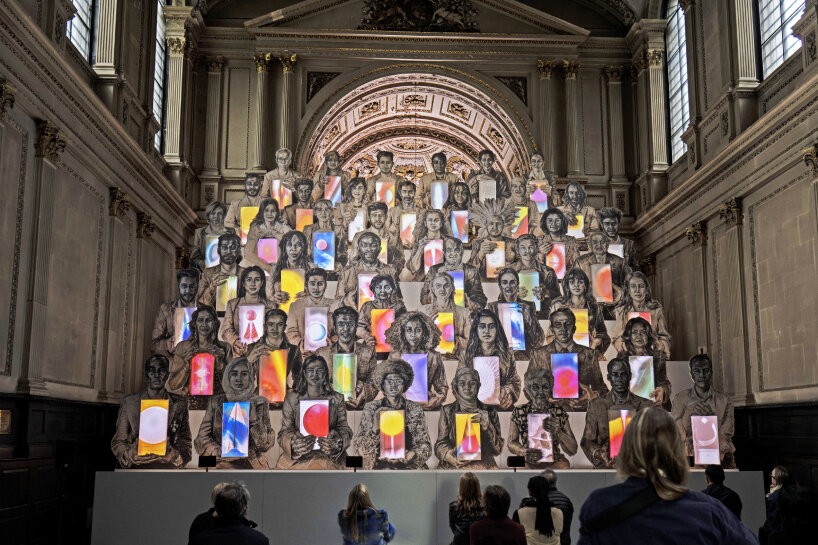
the show projects animated light paintings onto the empty boxes | photo by Daniel Devlin
INTERVIEW WITH ES DEVLIN
designboom (DB): We were reading through the project and saw that Congregation is a collaboration with the UK for UNHCR. Has this partnership been going on since the last time we saw each other at Art Basel 2024?
Es Devlin (ED): It actually began on February 24th, 2022, with the Ukraine war. At the time, I was working on the piece outside Tate Modern, where I was drawing 243 Londoners who are more than humans. I drew 243 London species, and I was working with the Wildlife Trust. At the end of that project, I changed. I had observed London species in detail for four months, not sleeping much, just drawing. I felt my hand achieve this porosity between my veins and the veins on a bat’s wing, between my skin and the scales on a lizard’s back, between the shape of my knuckles and the shape of a bird’s wing. I noticed that, at the same time, this devastating war broke out in Ukraine, and our country suddenly seemed to be showing porosity toward Ukrainian people, which I hadn’t felt before.
We had recently experienced a kind of brittleness in our discourse around identity, in relation to Brexit and Europe, and this felt like a refreshing shift in tone and intention countrywise. I started to sense dissonance, though, because the discourse was still getting louder. In October 2022, Suella Braverman, our then home secretary, used words like ‘invasion’ of small boats on the Kent coast. I found a real dissonance I was trying to reconcile. How, on one hand, am I reading an article that celebrates schools welcoming thousands of people from Ukraine, and yet people coming from Syria and Afghanistan on small boats are ‘invaders?’ I didn’t understand. I needed help. So, I went to the UK for UNHCR and said, ‘Please help me understand.’

Es Devlin in front of her installation in London, Congregation | photo by Daniel Devlin
ED (continued): They showed me the data and said, of all the displaced people, of which there are 117 million in the world at the moment, 73 percent of refugees are from five countries. That is Ukraine, South Sudan, Afghanistan, Syria, and surprisingly, Venezuela, which I wasn’t aware of. Of those, nearly 40% are being housed in just five countries, including Iran, Turkey, Pakistan, and Colombia. I thought, okay, you have six million displaced people from Ukraine and six million from Syria. Why are we not feeling the same porosity towards Syrians, for example?
When you get into the details, you have three million displaced from other countries, including Ethiopia and Somalia. They showed me the data, and I thought, well, there must be structures of separation—some structures of ‘otherness’—that we need to look at. Having drawn these animals and learned so much, I thought I better start drawing in order to learn. I did the project to perceive, draw, and learn about my own structures of separation, my own biases. So with the UK for UNHCR—and to answer your question—that’s how the project began.
DB: And what happened next?
ED: The UK for UNHCR then agreed to the portraits. They introduced me to 50 people from 28 countries. They chose people they thought would be appropriate for this encounter. Each person was briefed that the encounter was with a stranger, so they knew that when they arrived at my door, I would only know their first name. I would not know anything else about them—where they came from, whether they had come six months ago on a small boat or 60 years ago on a Kindertransport. I didn’t know anything at all. All I knew was that at some point they had come to London seeking refuge, but that’s all I knew, and there was a vast variety of circumstances.
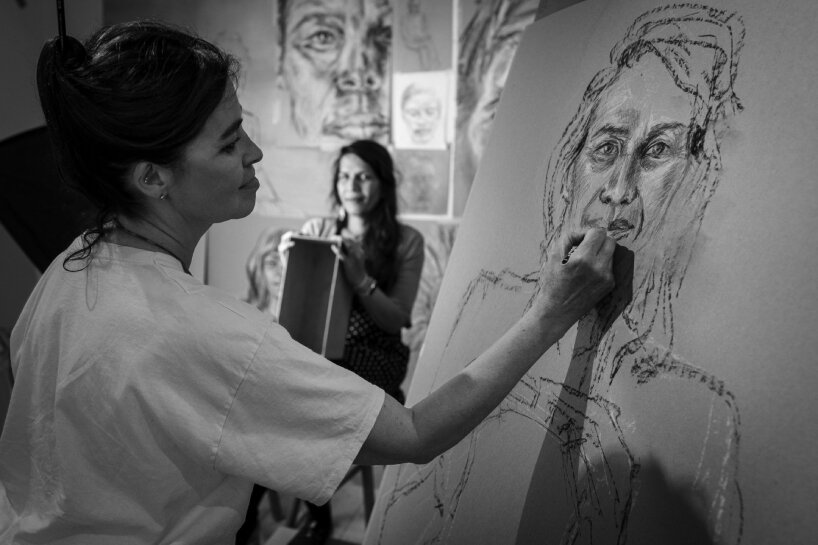
Shika Thibault in portrait session with Es Devlin for her installation in London | photo by Daniel Devlin
ED (continued): The idea worked this way: they sat, often with someone to offer support, if needed, or sometimes alone, in my studio in this very room. I gave each person the same empty box. I played the same piece of music, Max Richter’s Four Seasons, so we wouldn’t talk. We didn’t talk at all. I asked them to look straight into my eyes, which is quite difficult, even for us to do now in this interview. It’s not easy to sustain the gaze of another, whoever they are. In the process of drawing, we sometimes both started crying, just from the music and looking at each other.
What I encountered—much like with the animals—was that if you really stop and gaze at another living being, in the end, if you meditate on it, you perceive a microcosm of the whole universe in that being. I really perceived that and felt that I was in the presence of someone who encompassed the entire universe. I felt that about grasshoppers when I was drawing them, though they were from photographs, and it was more distant because I was just getting into the geometry. But it was the geometry of their forms where I felt that infinity.
I was drawing the people, the presence of the gaze with the music, Four Seasons, and the sunlight passing across their faces while I was illustrating them. At 44 minutes in Max Richter’s track, my alarm would go off. I’d stop the track, get the microphone, and say, ‘Tell me about yourself.’ There was a sense of relief on both sides. They were desperate to tell their story, and I was desperate to hear it. The portrait just sat there, as if saying, ‘Why were you concentrating on this when it’s all about that?’
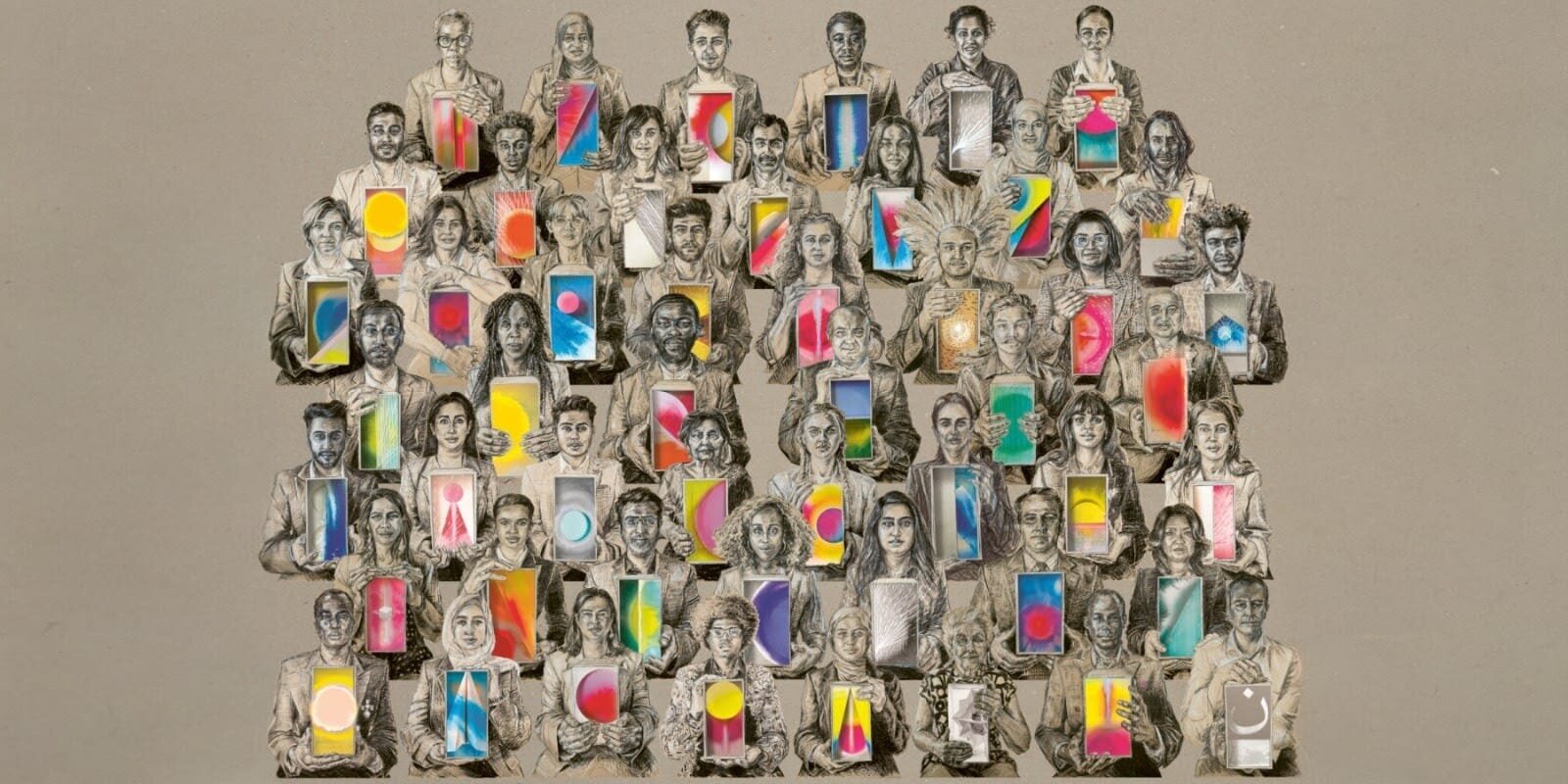
Courtauld edition of Congregation by Es Devlin
ED (continued): For example, I had never drawn anyone in a hijab before until Maya, one of the subjects. I felt a real responsibility not to mess it up, understanding how a hijab is wrapped. What was going on in my mind were associations with drapery, Renaissance sculptures, demure women. I spent a lot of time on that. Then Maya and I paused, and she said, ‘Right, I’m an airline pilot. I fly 737s.’ I thought, ‘Why didn’t I concentrate on her watch? Why wasn’t I looking at her big black Titus watch?’ There were a lot of examples of me recognizing my own bias.
When they left, I spent two more hours on each drawing. During those two hours, I listened to podcasts about their country and the conflict. I had five Syrians, so I listened to everything I could find about Syria, the history of the Syrian conflict, podcasts about the Ottoman Empire and the Byzantine Empire. I was trying to understand the roots of each conflict, which, sadly, many have their roots in London. That’s what I listened to while finishing the portraits.
DB: Why did you choose to wait until after the recording before starting the conversation? Was it because of what you mentioned, the presence of the gaze and being in that moment? Because 44 minutes of silence and intense gaze must have been some sort of reflection—it must have been intense.
ED: Quite intense, and I did it. I also asked everybody to wear a suit. I said, ‘Please dress as if you’re dressing for a formal occasion. If you really don’t want to wear a suit, just wear something you would wear formally.’ I did it because I wanted to destabilize my preconceptions, judgments, and bias. I wanted to have an encounter with a face to begin with. Later, someone came into my studio and asked, ‘have you read Emmanuel Levinas?’ I then went off and read a lot of Levinas. Interestingly, they were refugees, and their parents were killed by the Germans. They were Jewish, and they wrote this extraordinary philosophy of the face-to-face encounter.

portrait Of Amir Nizar Zuabi by Es Devlin for Congregation
ED (continued): What Levinas says is that the human face ordains and orders us. In the face-to-face gaze, you can be completely uprooted from history. The first commandment of the face-to-face encounter is, ‘Thou shalt not kill.’ There’s something fundamental about a face-to-face encounter, especially as life is now so mediated. Warfare is distanced through drone attacks; relationships are mediated via language, code, and screens rather than actual face-to-face encounters. You realize that in a face-to-face encounter with a stranger, 45 minutes is a very rare privilege. It took a specific architecture to set up a secure space so both sides felt safe.
I encountered layers that felt like TV static interference between me and the other—all my own understandable layers of preconception, association, and baggage that I bring to any encounter. I encountered it in a very clear way, which means I’m more able to recognize it in myself, talk about it, and hopefully, when people come to see the work, they can start recognizing it in themselves too. We can’t dismantle architectures of separation until we recognize them. The first step is to recognize that this is there—it’s an architecture. It’s there because I’ve been brought up like this, and I’ve grown up like this. There’s nothing wrong with it; it’s just there, right? If I can recognize that, I can just be a little more aware when I go to people, right?
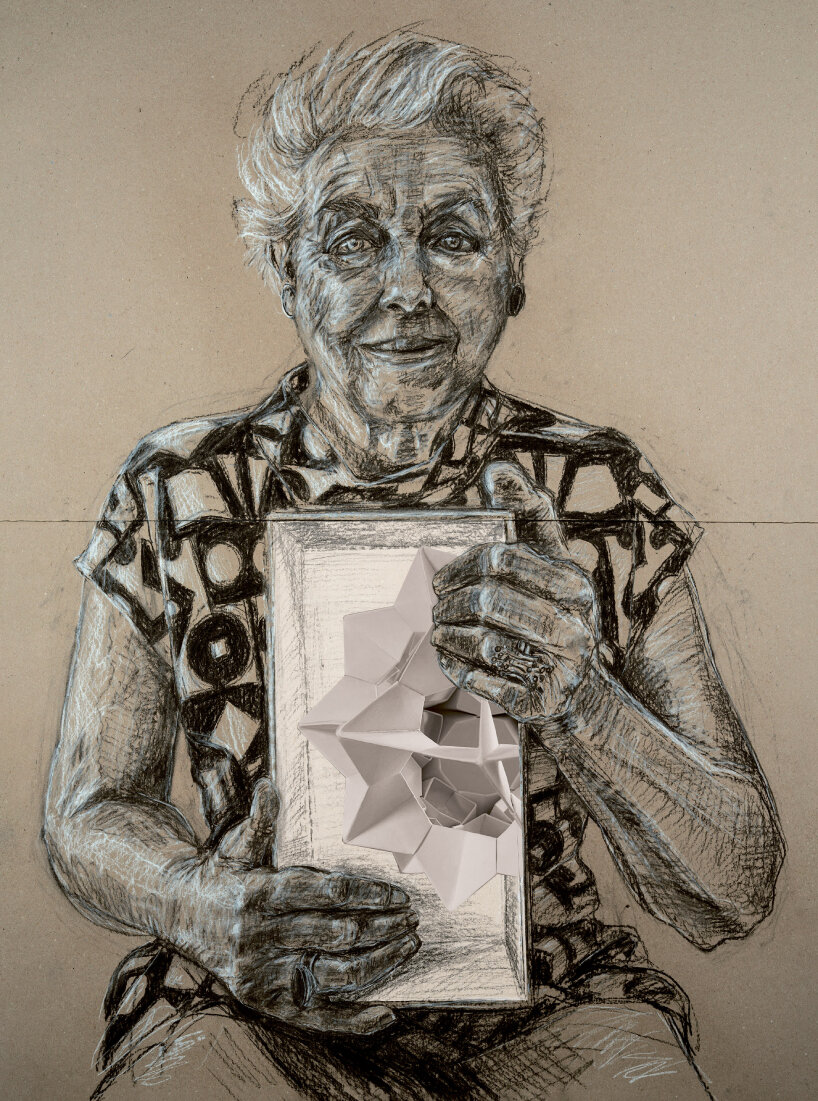
portrait of Dame Stephanie (Steve) Shirley Ch by Es Devlin for Congregation installation in London
DB: Right, and it’s great that you touched upon architecture because this installation is set to be presented and projected inside the St Mary le Strand church in London. Was it intuitive for you to choose this architecture to host the project, or was it based on research and the history of this place?
ED: It’s really interesting. A friend of mine, Lyndsey Turner, the theater director I work with lately, said about me to someone, ‘Es’ approach is both forensic and associative.’ I really like that description because I’m in a state of openness to allow ideas to come. Once the idea comes, I put my focus on it in a forensic way, researching to back it up and find out if it supports itself. In this case, I was cycling after visiting the portraits of Lucian Freud at the National Portrait Gallery, cycling from Trafalgar Square to the UK for UNHCR offices for a meeting. We still didn’t have an idea of what we were going to do. I happened to cycle past St. Mary Le Strand Church and along the Strand, one of London’s most ancient arteries of migration and procession from east to west.
Ekow Eshun, the curator of the show and installation, talks about that well in his article (in the book). I had been asking about St. Mary Le Strand, which had just become pedestrianized. I spent a lot of time around there at the Courtauld, and I had seen the Frank Auerbach exhibition of charcoal heads next to this church. We started discussing, ‘Let’s do portraits. How shall we do it?’ We thought about doing it outside, as we did with Tate Modern—maybe outside the Hayward Gallery or the South Bank Center. Then, I was drawn to doing it inside because of the intimacy of the encounter. I wanted it to feel like the commons, a place of congregation, and I thought about the St. Mary Le Strand church. I went to sit in it in January 2024 and listen to a concert. While sitting there, I thought about the three kings, the Magi, bringing gold, frankincense, and myrrh. I didn’t like the word ‘refugee’ much—it’s started to accumulate associations that aren’t helpful.
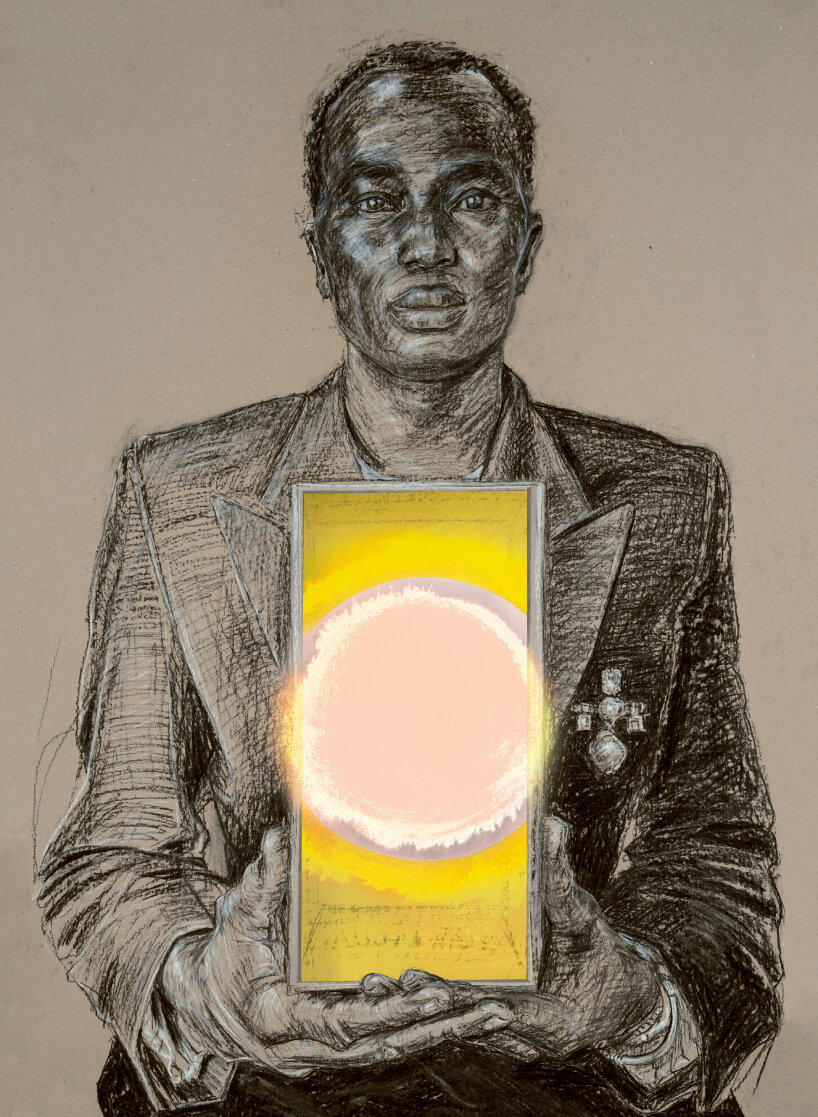
portrait of Dennis Okwera by Es Devlin for Congregation, her recent installation in London
ED (continued): I was looking for new words and thought: what about those who bring gifts, like the three kings? What if we start looking at this community not fearfully about what they’ll take, but excited about what they’ll bring? We could look at anyone being born that way. Any new birth migrates from pre-life into life through the womb—they’re still on a journey. Are they going to bring gifts, or are they going to take? We don’t know whether they’re coming through a birth canal or on a small boat. Let’s look at people like that.
I sat in the church and thought about its history because Ben Evans at the London Design Festival had guided me on London’s history. He reminded me that 50 churches were planned after the Great Fire of London, but only 12 were built. Something in me thought, a church should be a gathering place. This one has a small congregation. I thought, what if we could expand that congregation? Not everyone wants to go to church, but they could come to an art environment. So, what if we take the pews out, put in a white floor, small blocks for sitting, and conjure it with light, sound, and sculpture?
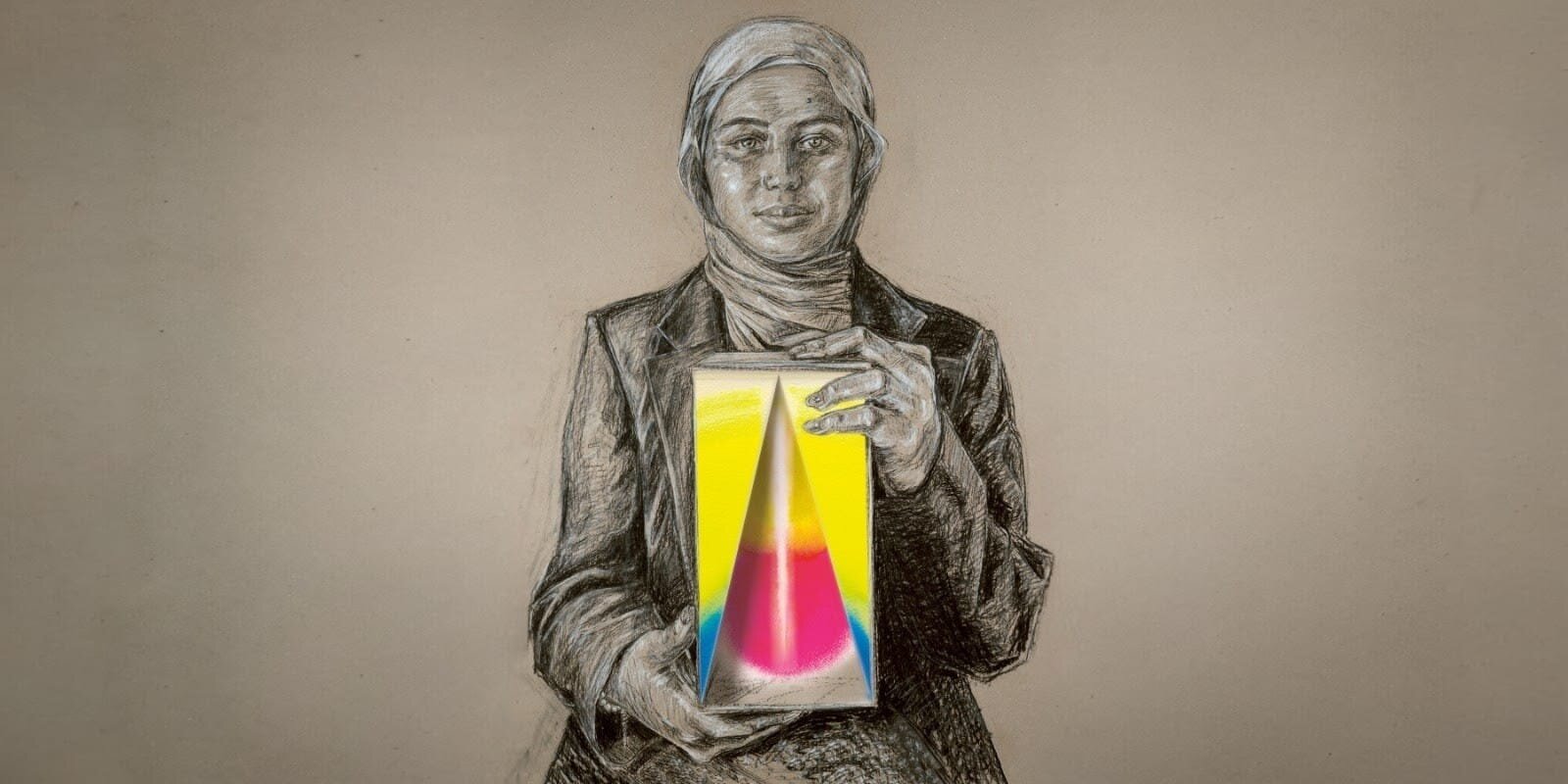
portrait of Laila Majeed by Es Devlin for Congregation, her recent installation in London
ED (continued): I thought, let’s do 50 portraits. At first, I had them scattered around the church, so you could encounter them one at a time. Then I thought, I want to make this a kind of show. I thought about the church because it had been on my mind, and when I sat in it, the project started to form in relation to the space. I chose the church because of the new pedestrian area around it. London lacks spaces like piazzas, unlike Milan. We have Trafalgar Square, but I felt the Strand should be celebrated as a commons.
People can sit, gather—they don’t have to go into the church. We’ll have choirs singing outside each night, and you can also go for free into the church for an intimate encounter like I had. What I hope you’ll experience in the church is a microcosm of my six months. I describe to people what happened when I drew—how it worked. You hear some of the voices and some music, and you can scan a code to listen to every story in everyone’s own voice, learn more, and find out how to get involved. The choice of the church, I hope, will start to put it more on the map as an arts environment and a place of the commons.
DB: I feel like this is your gift to us since we’ve been talking about gifts. There are a lot of surprises in store for us. Speaking of gifts, that was the first thing that came to our mind when we read that you ask your subjects to hold an empty box. Looking at the drawings behind you in your studio, it looks like it’s just an open box. But in other images, there are illustrations, colorful ones, inside the box. How did that happen?
ED: What happens is I draw them while they’re holding an empty box, which is oddly the box that contained the awards somebody gave me. I just grabbed it and asked the 50 people to co-author with me what goes in their box. I said, ‘just tell me some ideas.’ They all have different ideas of what they wanted in there—some more literal, some more abstract. Someone wanted a bird, someone wanted a specific instrument, all different things. Someone wanted a word, somebody wanted a gesture. I spent some time in my studio making paintings. I photographed the painting at every stage, so the paintings are made out of time.

portrait of Olga Tsybytovska by Es Devlin for Congregation, her recent installation in London
ED (continued): I had to leave this studio. I got quite ill at the end of the process. I lost my voice. Oddly, I made all of this. I then started making these collage paintings in a different room out of London. I left London, went to the countryside, and sat in a room with just light and paint. I did them all weekend and then put them in. These light paintings will only exist in the form of projected light. When you go and see the installation show inside St Mare Le Strand, it’ll start with an empty box. You’ll then see a beautiful sequence of dancers in the box. Finally, at the end, when the choirs start, you’ll see these colored stained glass windows animated, appearing like miniature theaters, showing the drawings that each subject chose for their empty box.
These prints are also part of the book, which costs 25 pounds per copy. 20 pounds of its goes to the UK for UNHCR, which is amazing. You can also buy postcards of the drawings, which are joined together so you unfold them and see all the drawings. On the back is each person’s definition of home. The profit from this goes to the UK for UNHCR. All of these products are there to generate funds. We hope people will want to sign up and give regular gifts, but it’s not a campaign as much as anything else. It’s a piece of art.
DB: It might be a bit obvious that all the stories that our 50 portraits shared with you are important, but are there any conversations that have stayed with you?
ED: The one I just mentioned, Maya. Personally, I got obsessed with her hijab and getting it right and all those associations. Then, she said, ‘Yeah, I’m a pilot,’ and told me her story. She came here from Syria at age 16; her brother was 11. Their school was being bombed as they were trying to do their exams. It was too risky. They needed to leave. There were too many life-threatening experiences, too many friends killed. They managed to apply for asylum and leave. When they got here, her brother, because he was 11, was welcomed into the education system. But not her. She was 16, and her A grades from Syria meant nothing. She couldn’t speak a word of English. They said, ‘Well, you’re uneducated, so no school for you.’ She could do some volunteer work and couldn’t do any skilled work or education, but she just wasn’t prepared to accept that because she was an A student.
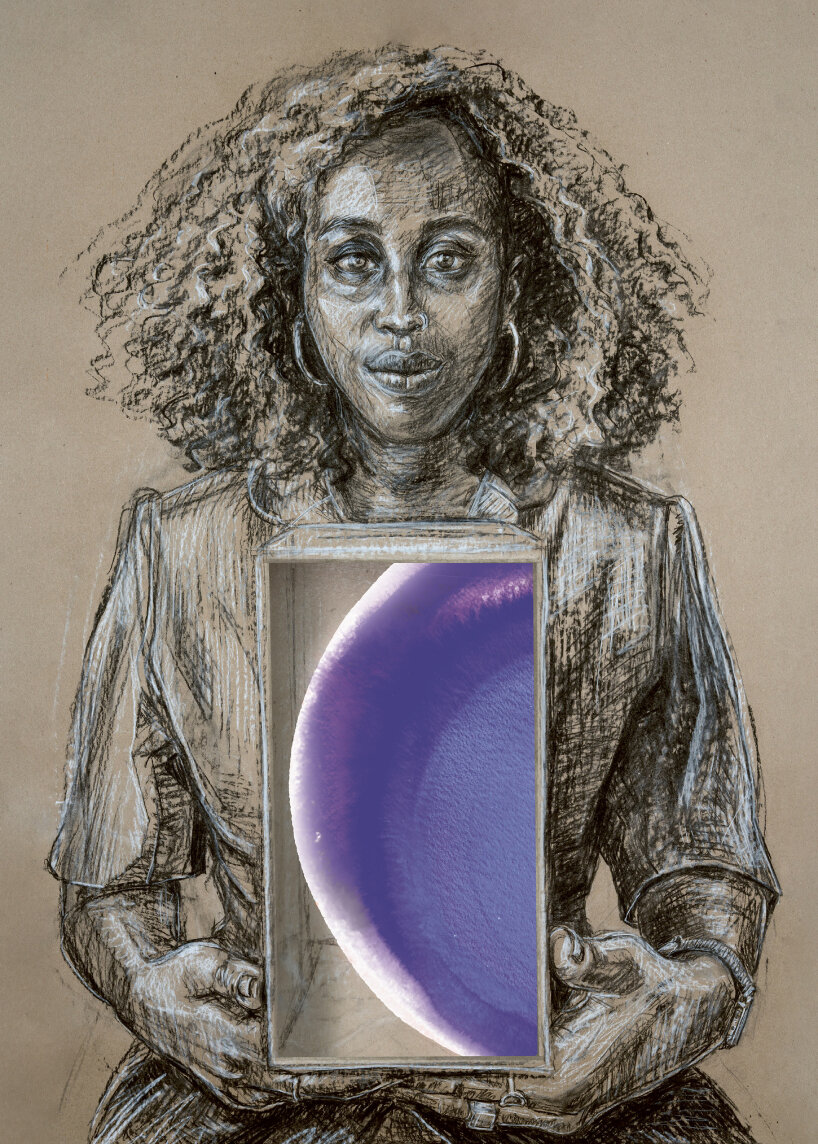
portrait of Ornella Mutoni by Es Devlin for her London installation, Congregation
ED (continued): So she taught herself English, listened to pop songs to perfect her accent, watched TV to learn it, and volunteered everywhere. Although she felt rejected by the school system, she threw herself into her community. Eventually, the school accepted her onto a course in mechanical engineering. One day, she was looking at planes taking off through a hotel window with her mother and had a dream of controlling planes. She said, ‘I’d like to be in control of that.’ She loved the geometry, the pattern. But her friends and teachers said, ‘Maya, be realistic. You’re Syrian, you’re a refugee, you’re a woman, and you’re wearing a headscarf. No one’s going to trust you to control an airplane.’ She was determined. She thought, ‘I want to be a pilot.’
Firstly, only five percent of the world’s pilots are women. Secondly, it’s ridiculously expensive to learn to be a pilot. Most pilots become pilots because they’re sons of pilots. Most Syrian refugees in England who are women do not become pilots. But she was determined. She got on a sponsored course by the airline TUI, and she just graduated from it. Now she has her pilot’s license. She said something beautiful about London: ‘I love Damascus, I loved Syria, this was my home. Now I fell in love with London. When I walk around London, I think, ‘Yeah, this is me.’ I found that so moving; it made me proud to be a Londoner.
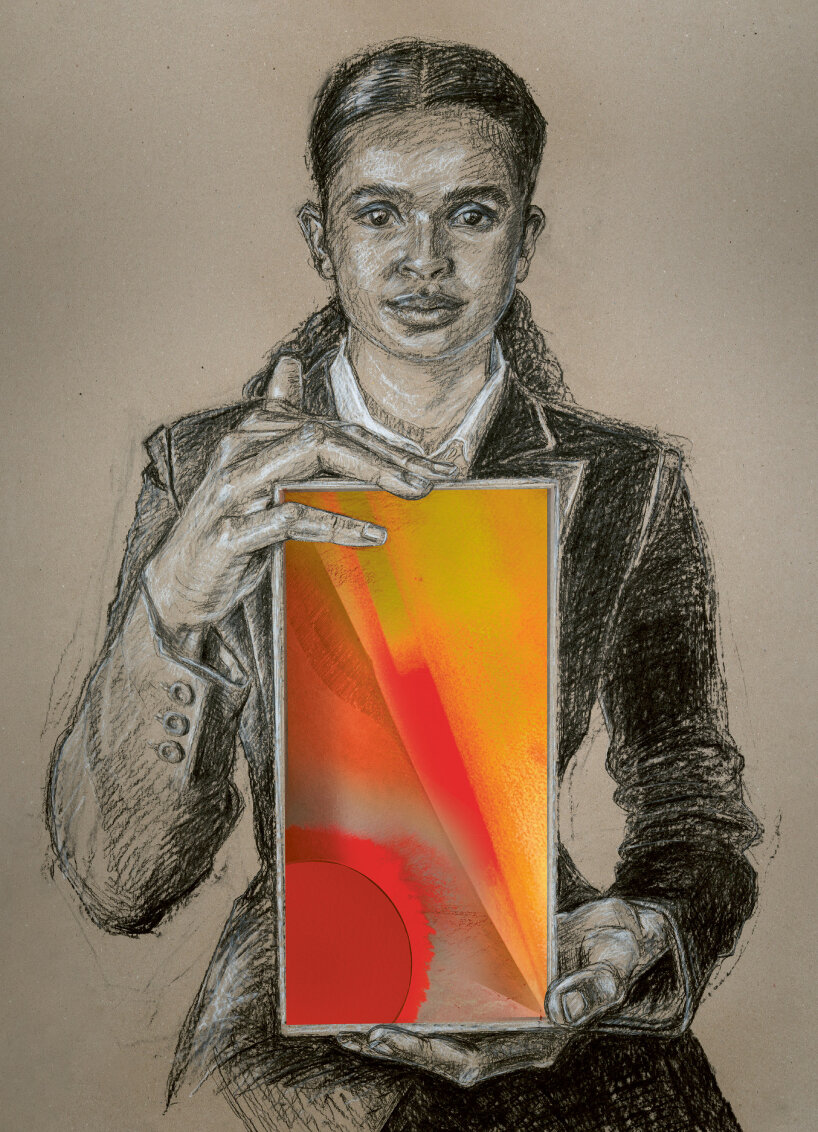
portrait of Ramla Ali by Es Devlin for her London installation, Congregation
ED (continued): There’s a beautiful story of Luka, who comes from Bosnia. He came here at age seven. He was shoved into a giant cargo plane full of refugees during the Bosnian war and fainted on the way here. Now he’s a security fund manager. He says that ‘as a refugee, you’re always hankering after security and safety. Now, through my job, I try to provide financial security for people.’ He said something moving: ‘I’m really patriotic. Put a flag in my box. I love this country. I’m a delighted participant as a British citizen. I pay my taxes with a smile.’ The last one was Dame Stephanie Steve Shirley. She’s 90 and successful; she became a billionaire and gave all her money away.
She came on the Kindertransport as a Jew from Germany at age six. She said, ‘Two days on that train defined my whole life. Everything I’ve done since has been defined by those two days.’ She said, ‘I’m not political, but I am a patriot. I love this country with a compassion that only someone who’s lost their human rights could feel.’ I think people who watch the show, see the installation, and are Londoners will feel a real sense of pride to be part of a community that includes these people. I think they’ll be proud to be part of this gang, and I hope they’re happy.
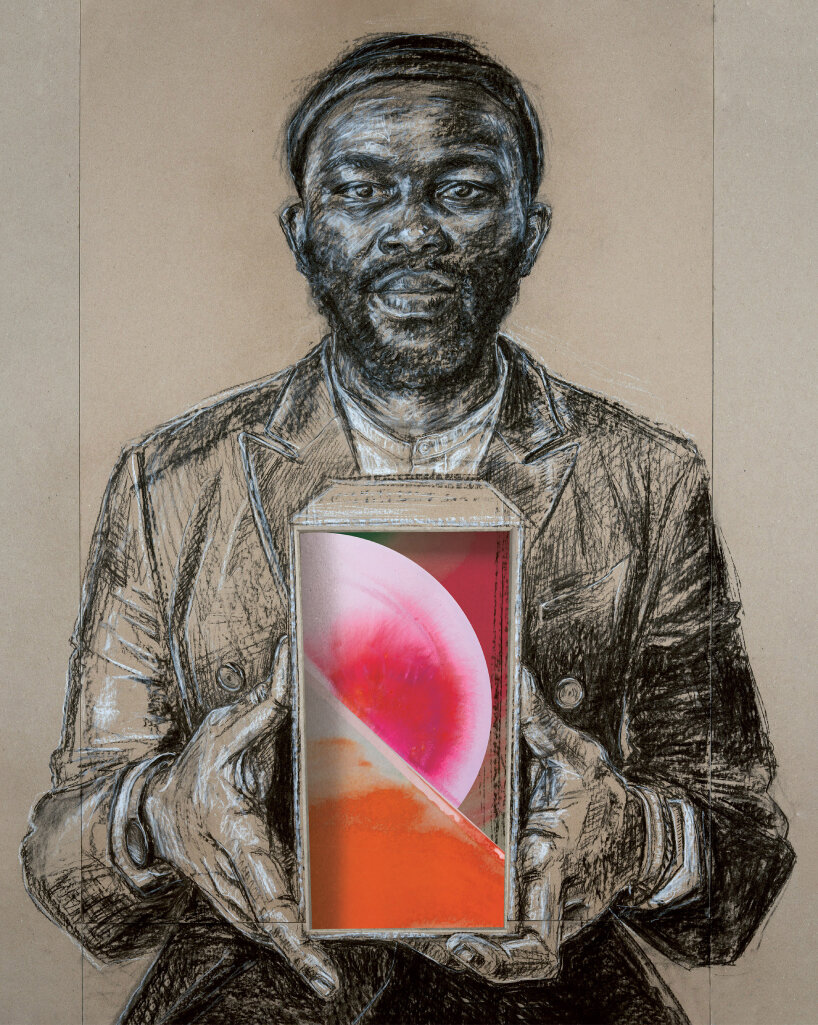
portrait of JJ Bola by Es Devlin for her London installation, Congregation
DB: And Es, what has this entire experience made you aware of?
ED: I think it’s multifaceted, the encounter with one’s own overlays and biases. When people like me walk in and look at these drawings, they’re not encountering a person; they’re encountering a drawing of a person. I’ve told everyone in chalk and charcoal, so they’re all conjoined by that material. They’ve come through my gaze. But I think there will still be a level of bias that each person encounters when they see each of these co-authors. They will hear 10 voices when they sit and watch the show, but they will hear 50 voices in their minds and read 50 stories if they read the book. I hope that with each encounter, they, like me, have a complex reaction where they meet their own expectations from looking at the picture to reading the story.
The word ‘refugee’ gets somewhat reframed for people. I’ve been careful in my use of it. I talk about those who seek sanctuary, those who’ve experienced false displacement from their land of birth, and those who bring gifts. I don’t really use the word ‘refugee.’ I think it was a word with great dignity, and when I asked each subject what they thought of the word ‘refugee’, they all gave me their answers and guided me. Some didn’t like it, some love it, but most agree that it had a lot of dignity back in the 1950s after the war when the UN and the UNHCR were founded.
Unfortunately, the use of that word in the media and the discourse around small boats is not helpful to that word. I hope that people have a new reframe around that word. I feel like this experience is a bit like introducing friends. I’m introducing my friends to my friends. When you’re setting a table at a dinner, it’s about who will get along with whom, and I’m introducing 50 of my community in London to this new community of viewers.
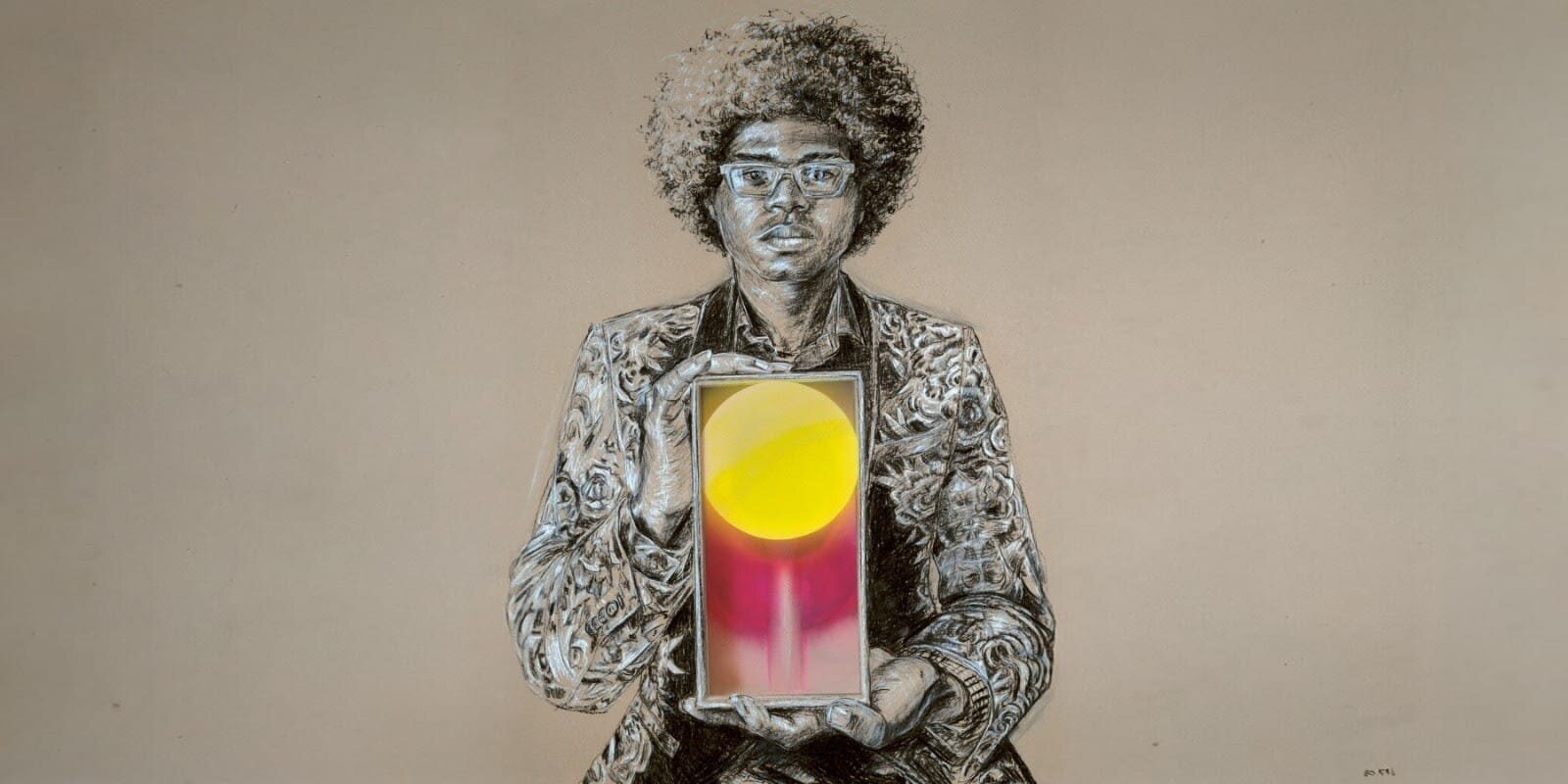
portrait of Joel Nkeonye Mordi by Es Devlin for Congregation, her London installation
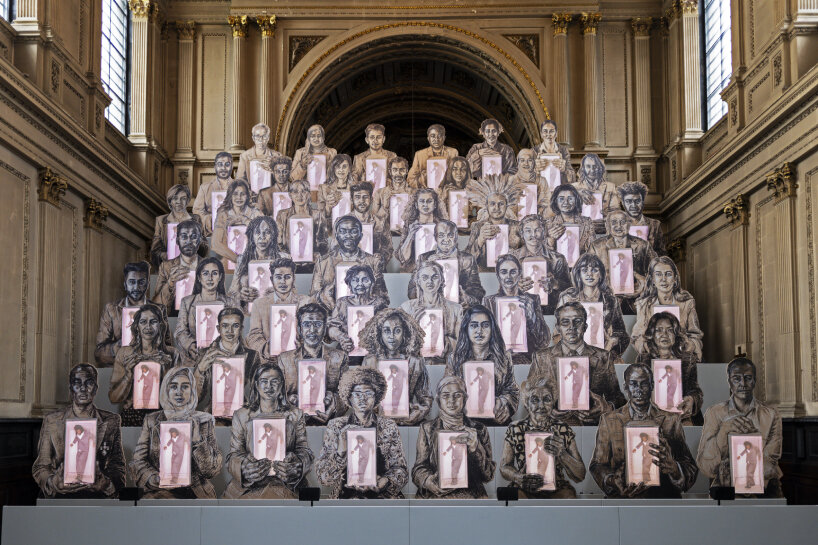
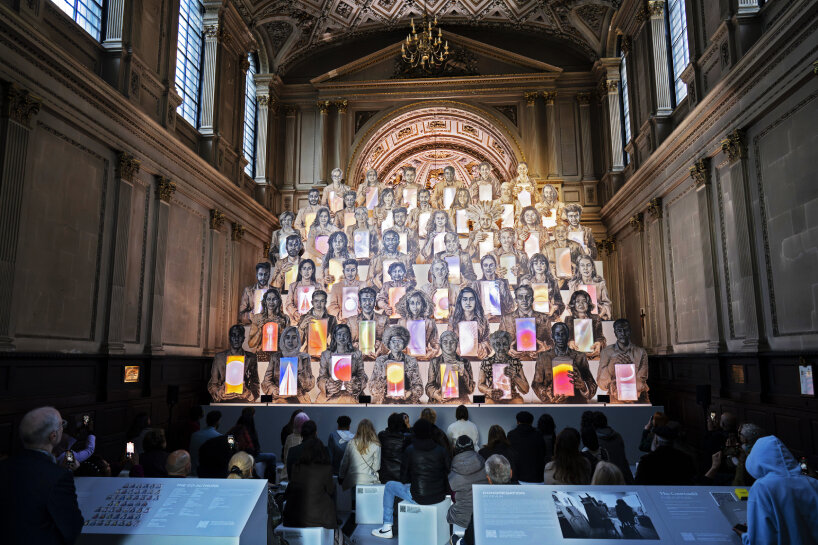
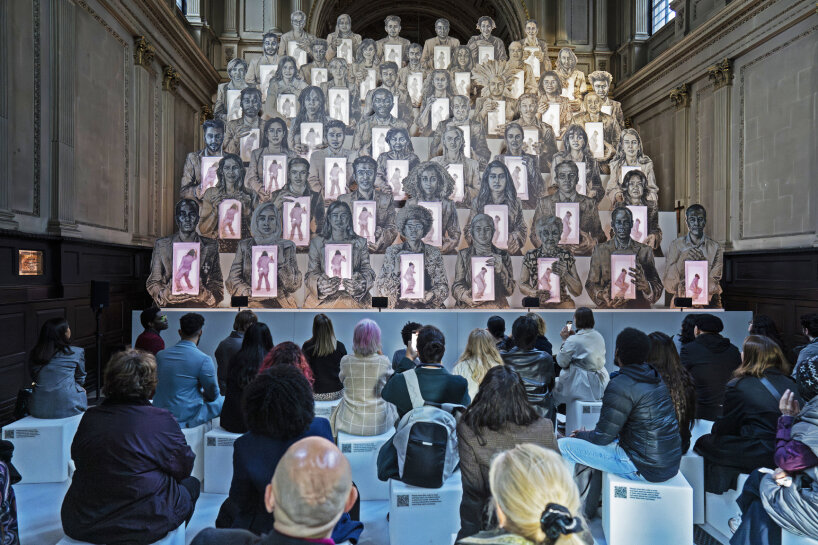
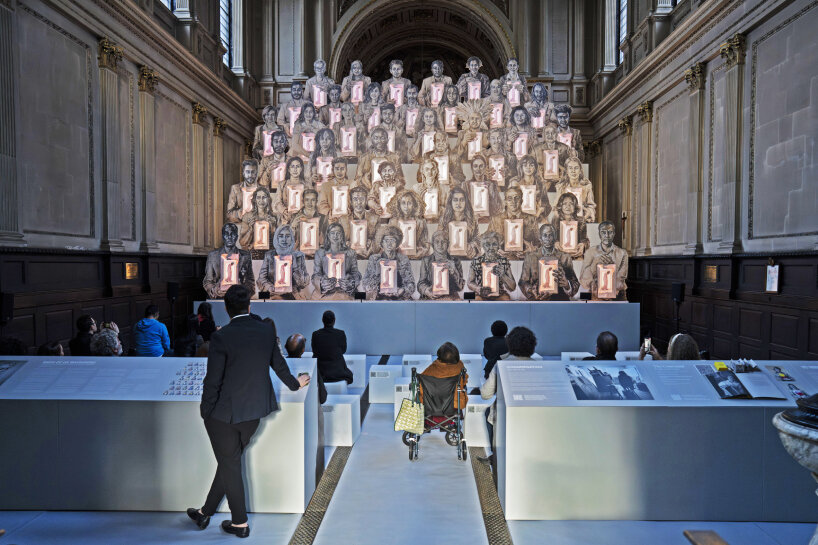
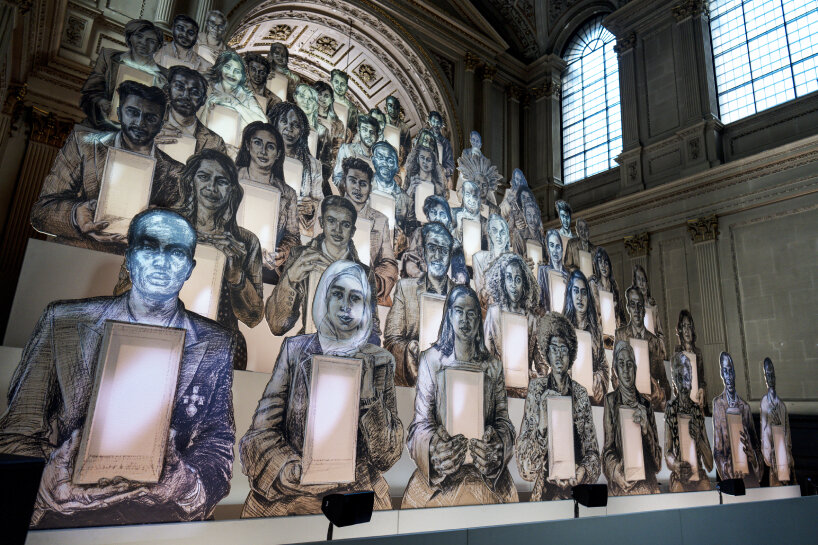
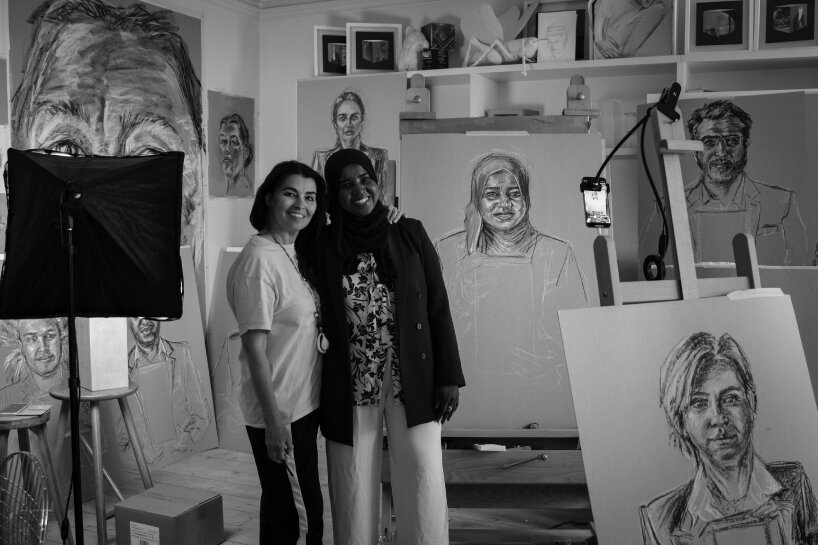
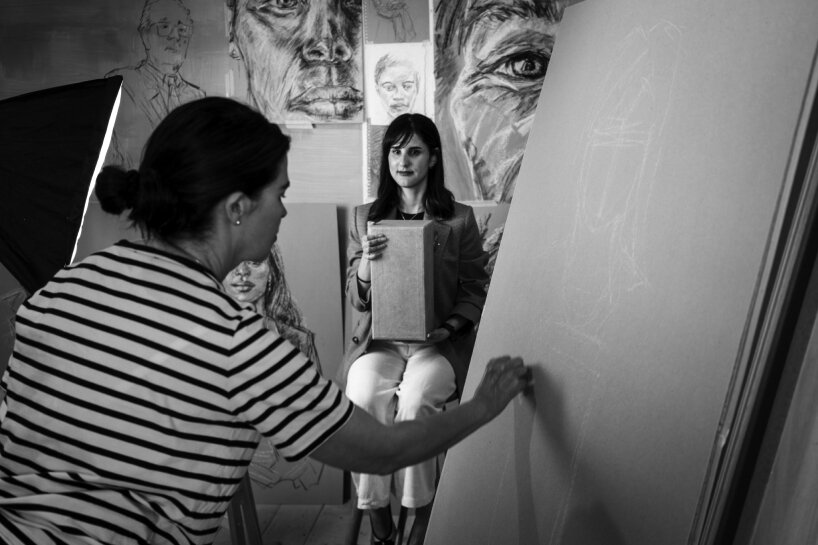
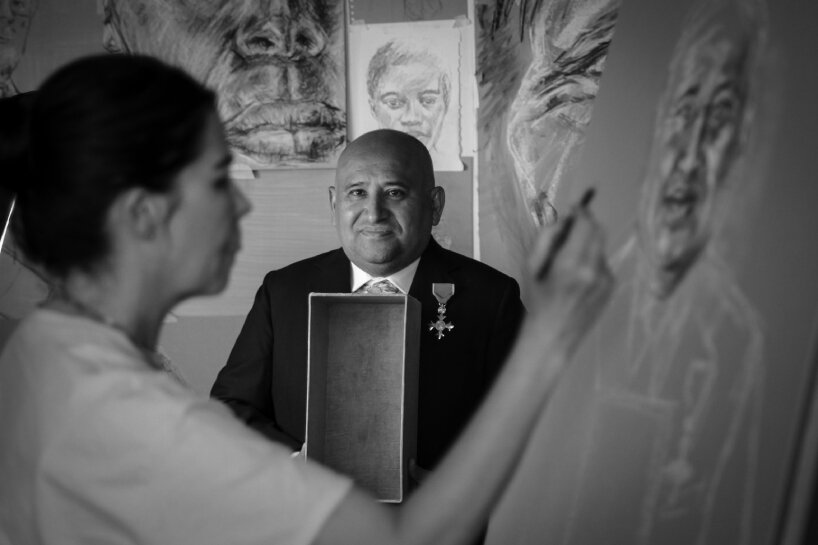
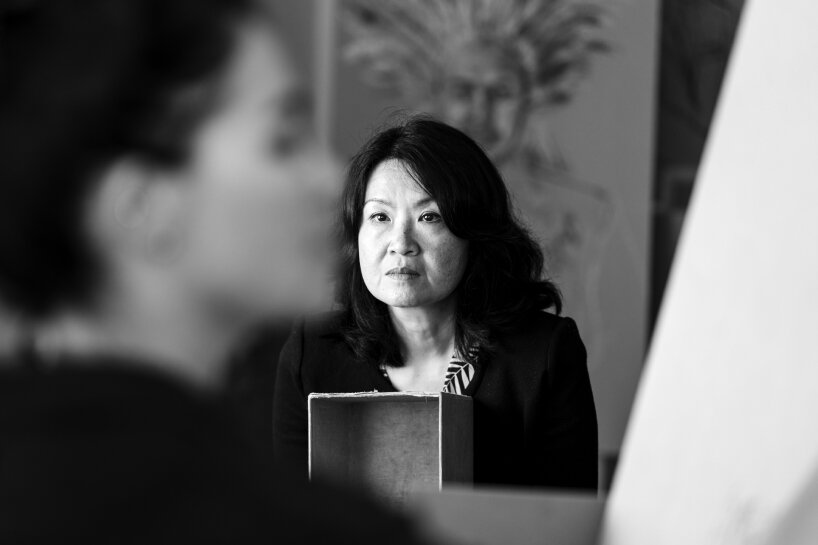
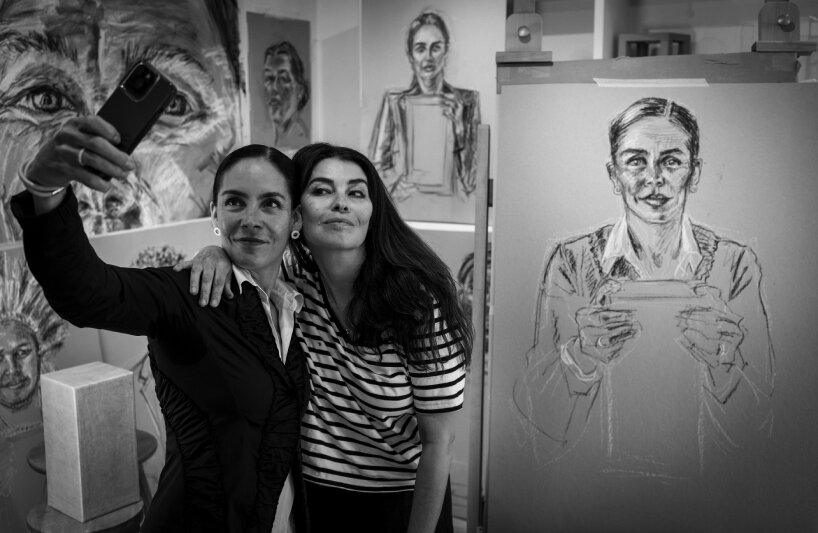
project info:
name: Congregation
location: St Mary le Strand Church, London, WC2R 1ES, England | @StMaryleStrand
dates: October 4th to 9th, 2024
tickets: here | for the talk, here
curator: Ekow Eshun | @Ekoweshun
partnership: UK for UNHCR, The Courtauld, King’s College London | @unrefugeesuk, @courtauld, @lifeatkings
filmmaker: Ruth Hogben | @RuthHogben
choreographer: Botis Seva | @botissevafilm
dancer: Joshua Shanny-Wynter | @joshuawynter
sounds: Polyphonia, JJ Bola | @polyphonia_studio, @jj_bola
album: Recomposed by Max Richter: Vivaldi’s Four Seasons | @maxrichtermusic
book: here
happening now! with sensiterre, florim and matteo thun explore the architectural potential of one of the oldest materials—clay—through a refined and tactile language.
